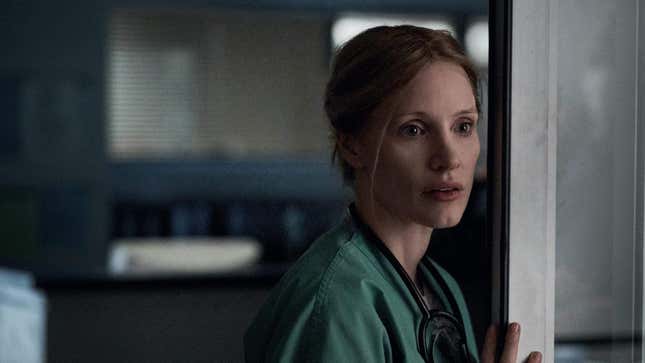
From A Hijacking to A War, filmmaker Tobias Lindholm has demonstrated an assured, skillful sense of vision, tone, and meticulous character design. His fourth directorial feature (his first in English), The Good Nurse, does the same while delivering an ingeniously subtle, precisely crafted nail-biter. He and screenwriter Krysty Wilson-Cairns (1917) refreshingly re-center author Charles Graeber’s non-fiction novel, The Good Nurse: A True Story Of Medicine, Madness And Murder, not on its eponymous perpetrator, but on one of the informants who helped bring him to justice: a stressed single mother who suspects her trusted colleague has been intentionally killing patients. That shift gives the mystery a dynamic, cinematic resonance—one that expands the real-life tale to scrutinize a healthcare system that can allow bad practices to go unchecked for years.
Amy (Jessica Chastain) is fairly new, working tough night shifts as an ICU nurse, and battling ailments of her own. She’s in desperate need of a heart transplant, but hasn’t accrued enough time for her health insurance to kick in. She’s also financially and emotionally stretched, as her wages are low and she has little time to spend with her two cute-as-buttons daughters at home. They too are starting to feel the pangs of motherly neglect, acting out at their kindly babysitter. The pressure to make ends meet and keep up the demanding pace is at an all-time high.
Life changes for Amy, however, once Charlie (Eddie Redmayne) is hired. He comes highly recommended and has extensive medical knowledge, in addition to a tender bedside manner. Clean-cut, friendly and unassuming, he ingratiates himself into Amy’s life, helping her maintain her well-being, slipping her heart medication on the sly, and cozying up to her daughters. But a patient’s unexplained death sends a red flag up the administrative chain, eventually landing in front of Detectives Braun (Noah Emmerich) and Baldwin (Nnamdi Asomugha). As the investigators face a tangle of bureaucratic red tape and obstacles, many deliberately placed by the hospital’s slippery risk officer (Kim Dixon), Amy emerges as key to their case.
Part of what makes the ensuing suspense percolate perfectly is how the filmmakers construct characters, their conundrums, and conflicts. The way they set up Charlie’s sociopathic denial is subtle and sinister. They drop tiny breadcrumbs for the audience to follow when it comes to his clouded past. His confessions to Amy range from an accusing ex-wife who forbade him to see his kids to a workplace argument that led to a trumped-up complaint. He admits these things with casual candor as if attempting to stir sympathy, but it’s clear he’s telling her half-truths to suit a new narrative he’s spinning, omitting pertinent details as to what actually happened.
Still, the mystery is less a whodunit and more about how Charlie’s deadly deceit was allowed to flourish for 16 years under the noses of so many, illuminated by procedural scenes that portray hospitals’ liability-reducing strategies. These sequences—in which the detectives try to coax simple answers from current employees, previous employers, and the uncooperative administration—are meant to make one’s blood boil. This malevolent rot from the inside provides a silent, slow-creeping insidiousness, running concurrently with the picture’s actual villain.
Sequences exploring Amy and Charlie’s friendship—and inevitable betrayal— ooze with dread and unease. Tension reaches a fever pitch after Amy uncovers irrefutable evidence and passes out. Lindholm conducts the subsequent events with subdued gusto, employing a nefarious, slow pan and sound cues to augment the narrative punch. His visual dexterity is again on display when Amy finds Charlie in her living room sidling up to her kids. Lindholm’s use of close-ups not only showcases the actors’ disarming delivery, but also heightens discomfort levels, imparting a destabilizing, overwhelming sense of claustrophobia from Amy’s perspective.
The fabric woven is delicately textured both in its aesthetic components and within the performances. Cinematographer Jody Lee Lipes and production designer Shane Valentino maintain a consistent tone via a restrained color palette—a cyan-yellow that’s interestingly juxtaposed in scenes, whether they take place in a hospital, board room, or home. Amy Westcott’s costume design, by way of the cozy cardigans sported, adds tangible character detailing. Chastain taps into deeply faceted reserves of vulnerability, raw honesty, and compassion as her character’s strength. Redmayne turns in his best work to date in this understated portrayal that’s both evocative and elucidating.
Feeling like a well-balanced cross between an investigative procedural like Spotlight and ’90s-era chillers like The Hand That Rocks The Cradle where a seemingly harmless helper disguises their sinister self, the filmmakers have created a strong throwback thriller. The time it devotes to the victims is shamelessly manipulative, but it’s there to serve the greater good, demonstrating who the titular nurse is and the empathy at her core.